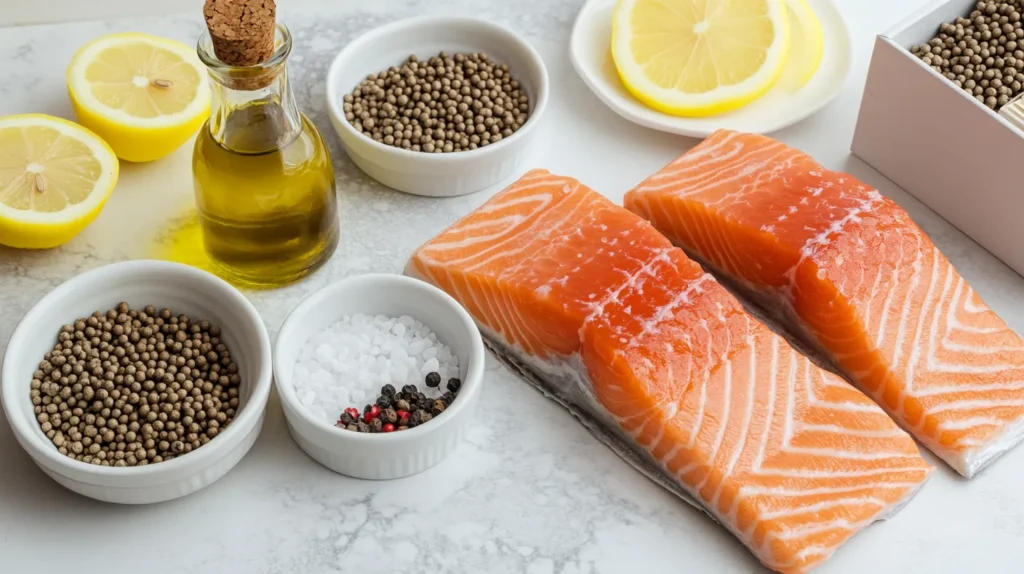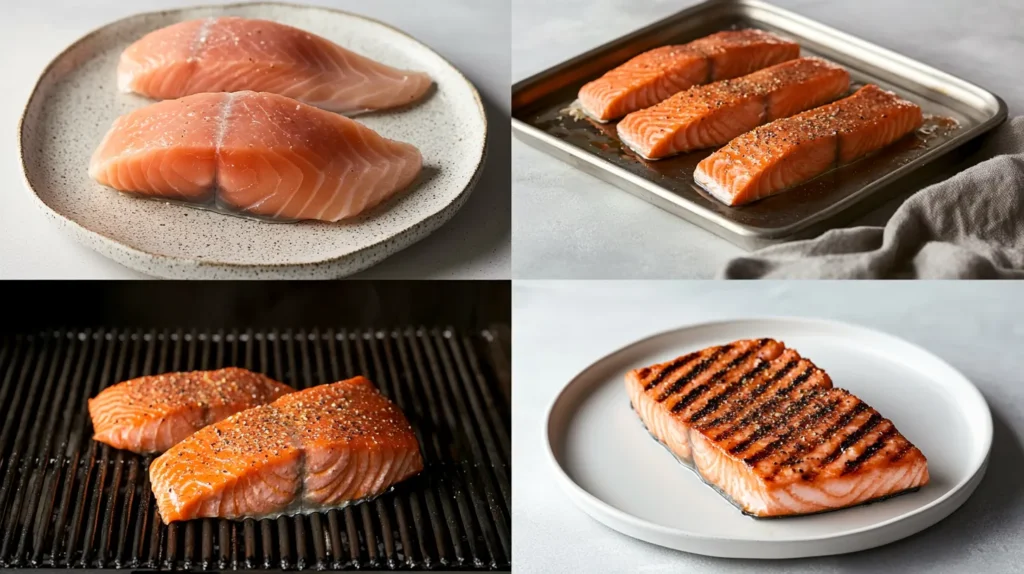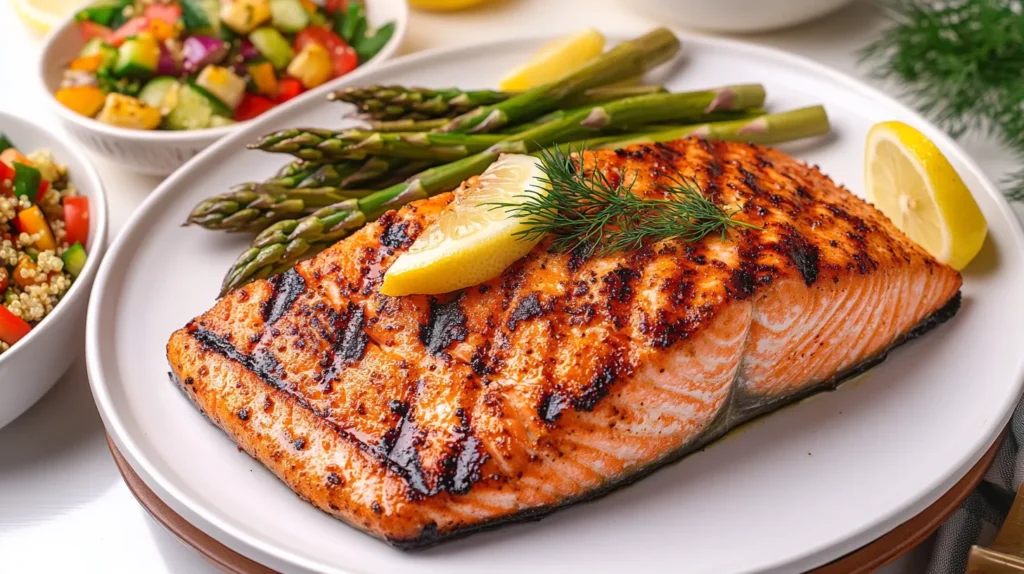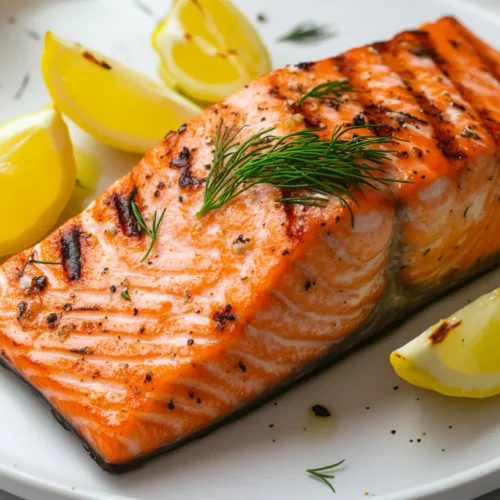There’s nothing quite like perfectly grilled salmon on a Traeger. The wood fired flavor, the flaky, tender texture, and the beautifully caramelized crust make this a dish you’ll want to cook again and again. Whether you’re a seasoned griller or trying your Traeger for the first time, this recipe delivers restaurant quality results with minimal effort. Grab your favorite salmon fillet, fire up the grill, and let’s make the best Traeger grilled salmon you’ve ever tasted!
Table of Contents
The #1 Mistake People Make When Grilling Salmon
The biggest mistake people make when grilling salmon? Overcooking it! Salmon is delicate, and just a few extra minutes on the grill can turn it from juicy and tender to dry and tough. The key is to cook it just until the internal temperature reaches 125°F to 130°F for medium or 145°F for well done. Using a Traeger grill helps lock in moisture while adding that irresistible smoky flavor. Keep a meat thermometer handy, and you’ll never have to guess again!
Why You’ll Love This Traeger Grilled Salmon
- Smoky, restaurant quality flavor – Cooking on a Traeger infuses the salmon with a deep, rich smokiness.
- Super easy to make – With just a few simple ingredients and a Traeger grill, this recipe comes together effortlessly.
- Healthy and packed with nutrients – Salmon is rich in omega 3 fatty acids, protein, and essential vitamins.
- Versatile and customizable – Keep it simple with salt and pepper, or try a delicious marinade or dry rub.
- Perfect for meal prep – Make extra and enjoy it throughout the week in salads, wraps, or grain bowls!
Ingredients You’ll Need
Essential Ingredients

To make the best Traeger grilled salmon, you’ll need just a handful of ingredients:
- Salmon fillets – Fresh, wild caught salmon is best for maximum flavor and texture.
- Olive oil – Helps prevent sticking and enhances the salmon’s natural richness.
- Salt and pepper – Simple, classic seasonings that let the smoky flavor shine.
- Lemon juice – Adds brightness and balances the richness of the fish.
- Wood pellets – Apple, cherry, or alder wood pellets work best for a mild, smoky flavor.
Note: You can find the printable recipe with exact measurements below.
Variations and Substitutions
Best Seasonings for Salmon
If you want to switch things up, try these delicious seasoning options:
- Classic Lemon and Herb – Garlic powder, parsley, and a squeeze of lemon.
- Cajun Spice – Paprika, cayenne, garlic, and onion powder for a bold kick.
- Asian Inspired – Soy sauce, ginger, and sesame seeds for a savory umami twist.
Marinade vs. Dry Rub
Both marinades and dry rubs work well, but each gives a different result:
- Marinade: Adds moisture and infuses deep flavor. A simple mix of olive oil, soy sauce, honey, and garlic works wonders.
- Dry Rub: Creates a flavorful crust with bold spices. A mix of smoked paprika, brown sugar, and black pepper enhances the salmon’s natural richness.
Low Carb and Keto Friendly Options
Looking for a low carb or keto friendly version? Stick with simple, whole ingredients:
- Skip the sugar – Use smoked paprika and garlic instead of sweet rubs.
- Opt for a healthy fat boost – Brush with melted butter or avocado oil for extra richness.
- Pair with keto friendly sides – Serve with roasted asparagus, cauliflower rice, or a fresh avocado salad.
How to Make Traeger Grilled Salmon
Step by Step Guide to Grilling Salmon

1. Choosing the Right Cut of Salmon
For the best results, choose fresh, wild caught salmon like sockeye, king, or coho. These varieties have a richer flavor and firmer texture compared to farm raised options. Look for fillets that are vibrant in color, moist, and free from any strong fishy odor. If using frozen salmon, thaw it overnight in the fridge for even cooking.
2. Preparing the Salmon for the Grill
Start by patting the salmon dry with a paper towel to remove excess moisture. This helps the seasoning stick and promotes even cooking. If your fillet has pin bones, use tweezers to remove them. Keeping the skin on is recommended, as it acts as a protective barrier, preventing the salmon from falling apart while grilling.
3. Seasoning and Marinating Options
You can keep things simple with just olive oil, salt, and pepper, or elevate the flavor with a marinade or spice rub. For a bright, citrusy kick, marinate the salmon in lemon juice, garlic, and Dijon mustard for 30 minutes. If you prefer a smoky, caramelized crust, use a brown sugar and paprika dry rub for a delicious contrast of sweet and savory.
4. Setting Up the Traeger Grill
Preheat your Traeger grill to 350°F and let it heat up for at least 10 to 15 minutes with the lid closed. Use apple, cherry, or alder wood pellets for a mild, slightly sweet smoky flavor that complements salmon perfectly. Lightly oil the grates or place a sheet of parchment paper to prevent sticking while cooking.
5. Grilling the Salmon Perfectly
Place the salmon skin side down on the grill grates. Close the lid and cook for 12 to 15 minutes or until the internal temperature reaches 125°F for medium or 145°F for well done. Avoid flipping the salmon to keep it intact. Once done, let it rest for a couple of minutes before serving to lock in the juices.
Alternative Cooking Methods
Smoking Salmon on a Traeger
For a deep, smoky flavor, set your Traeger to 180°F and smoke the salmon low and slow for 1 to 2 hours. Use alder or applewood pellets for a balanced smokiness. To enhance the flavor, brine the salmon in salt water for an hour before smoking, then season with a light rub for a beautifully rich taste.
Cooking with a Cedar Plank
Cooking salmon on a cedar plank infuses it with a subtle, woodsy aroma while preventing sticking. Soak the plank in water for at least an hour before grilling to avoid burning. Place the salmon directly on the plank and cook at 375°F for 15 to 20 minutes. The plank also helps retain moisture, keeping the salmon incredibly tender.
High Heat vs Low Heat Grilling
- High heat (400°F to 450°F): Creates a crispy crust and locks in moisture quickly, perfect for thicker fillets.
- Low heat (275°F to 325°F): Ensures even cooking and a more delicate texture, ideal for smoking or slow grilling.
- Best method: Start at a low temperature, then finish with a quick high heat sear for the perfect balance of texture and flavor.
Helpful Tips and Tricks
Secrets to Perfectly Grilled Salmon
- Pat the salmon dry before seasoning to help create a crispy crust.
- Let it rest for a few minutes after grilling to retain juices.
- Use a meat thermometer to check doneness, 125°F for medium, 145°F for well done.
- Don’t over marinate; 30 minutes is plenty to avoid a mushy texture.
- Try a drizzle of honey or maple syrup before grilling for a subtle caramelized glaze.
Common Mistakes to Avoid
- Overcooking: Salmon cooks fast, so always check the internal temperature for perfect doneness.
- Skipping oiling the grates: Prevent sticking by lightly oiling the grill or using parchment paper.
- Flipping the salmon: Grill skin side down the entire time to keep it intact and moist.
- Choosing the wrong pellets: Strong woods like mesquite or hickory can overpower the salmon. Stick to mild woods like apple or cherry.
- Not letting the grill preheat: Always let the grill fully heat before placing your salmon for even cooking.
How to Serve

What to Serve with Grilled Salmon
Grilled salmon pairs beautifully with fresh, vibrant sides that balance its rich, smoky flavor. A crisp salad, roasted veggies, or a light grain dish makes the perfect complement. For a refreshing contrast, try serving it with Broccoli Cauliflower Salad, its crunchy texture and tangy dressing enhance the salmon’s deep, smoky notes. Other great options include garlic butter asparagus, quinoa, or lemon herb rice for a complete and satisfying meal.
Best Sauces & Garnishes
Enhance your Traeger grilled salmon with bold, flavorful sauces and garnishes:
- Classic Dill Sauce: A creamy blend of Greek yogurt, fresh dill, lemon juice, and garlic.
- Honey Garlic Glaze: A sticky sweet mix of honey, soy sauce, and garlic.
- Avocado Salsa: Diced avocado, tomatoes, red onion, and cilantro for a fresh twist.
- Lemon Butter Drizzle: Melted butter, fresh lemon juice, and a pinch of sea salt for richness.
- Garnishes: Sprinkle with fresh herbs, toasted sesame seeds, or a squeeze of lime for a finishing touch.
Traeger Grilled Salmon Nutrition Facts
Caloric Breakdown and Key Nutrients
Here’s a look at the nutritional profile of a typical serving of Traeger grilled salmon:
| Nutrient | Amount per Serving | Notes |
|---|---|---|
| Calories | 350 kcal | Approximate per fillet |
| Protein | 35g | High in lean protein |
| Carbohydrates | 2g | Minimal carbs |
| Fat | 22g | Healthy fats from salmon |
| Omega 3s | 1.8g | Supports heart and brain health |
| Sodium | 400mg | Adjusted based on seasoning |
| Vitamin D | 50% DV | Great for bone health |
| Iron | 8% DV | Found in wild caught varieties |
Health Benefits of Salmon
Salmon is one of the healthiest proteins you can eat. It’s packed with omega 3 fatty acids, which help reduce inflammation and promote heart health. It’s also rich in B vitamins, potassium, and antioxidants, which support brain function and immunity. Regularly including salmon in your diet can help with muscle recovery, skin health, and maintaining strong bones.
How to Make It Even Healthier
To keep your Traeger grilled salmon as healthy as possible:
- Use fresh, wild caught salmon, which has more omega 3s and fewer additives.
- Skip sugary marinades, opting for lemon juice, olive oil, and herbs instead.
- Pair it with fiber rich sides like roasted vegetables or a fresh salad.
- Reduce sodium intake by seasoning with citrus, garlic, and spices instead of salt heavy rubs.
How to Store & Reheat For Later
The Best Way to Store Leftovers
If you have leftover Traeger grilled salmon, store it properly to keep it fresh. Let it cool completely before placing it in an airtight container. Keep it in the refrigerator for up to 3 days. If you want to store it longer, freeze it by wrapping the fillet tightly in plastic wrap and placing it in a freezer safe bag. Frozen salmon stays good for up to 3 months. Always label your storage containers for easy tracking.
Reheating Without Drying It Out
To keep your salmon moist when reheating, avoid using high heat. The best method is to warm it in the oven at 275°F for 10 to 12 minutes, covered with foil to retain moisture. You can also reheat it in a skillet over low heat with a splash of water or broth. If using a microwave, place a damp paper towel over the salmon and heat it in 30 second intervals to prevent drying out.
Frequently Asked Questions
What temperature should I set my Traeger grill for salmon?
For the best results, grill salmon at 350°F. This allows it to cook evenly while developing a slightly crisped exterior. If smoking, set your Traeger to 180°F and let the salmon absorb the smoky flavor before increasing the heat to finish cooking.
How do I prevent salmon from sticking to the grill?
To prevent sticking, oil the grill grates lightly before cooking. You can also use a grill mat or parchment paper for easier handling. Cooking skin side down helps protect the flesh, keeping it from breaking apart when removing it from the grates.
Should I grill salmon with the skin on or off?
Grilling with the skin on is recommended as it acts as a barrier, keeping the fish from sticking and locking in moisture. If you prefer skinless salmon, grill it on a cedar plank or foil to prevent it from falling apart.
How do I know when my salmon is fully cooked?
Use an instant read thermometer to check the internal temperature. Salmon is done when it reaches 125°F for medium or 145°F for well done. If you don’t have a thermometer, check if the fish flakes easily with a fork that is a good sign it’s ready.
What are the best wood pellets to use for salmon?
Mild and slightly sweet wood pellets work best with salmon. Apple, cherry, and alder are great choices as they enhance the fish’s natural flavor without overpowering it. Avoid strong woods like mesquite or hickory, which can make the salmon taste too smoky.
Can I cook frozen salmon on a Traeger without thawing?
Yes, you can grill frozen salmon, but it will take longer to cook. Set your Traeger to 275°F and cook for 30 to 40 minutes until the internal temperature reaches 145°F. However, for the best texture and even cooking, it is recommended to thaw the salmon overnight in the fridge.
More Easy Seafood and Grill Recipes
- Cajun Shrimp Pasta Recipe – A spicy seafood twist that’s sure to impress.
- Crab Brûlée Recipe – A unique, caramelized take on classic seafood.
- Blackstone Chicken Recipe – For those craving a delicious grilled chicken option.
Enjoy your perfectly grilled salmon, and let me know in the comments how it turned out or if you added your own twist!

Traeger Grilled Salmon Recipe
Equipment
- Traeger Grill
Ingredients
Salmon Fillets
- 2 pieces salmon fillets 6 oz each, fresh and wild caught
- 2 tablespoons olive oil for brushing
- 1 tsp salt to taste
- 1 tsp black pepper freshly ground
- 1 tablespoon lemon juice freshly squeezed
Wood Pellets
- 1 box apple wood pellets for Traeger grill
Instructions
- Preheat your Traeger grill to 350°F for at least 10 minutes and lightly oil the grates.
- Pat the salmon fillets dry with paper towels and remove any pin bones. Season both sides with olive oil, salt, and black pepper.
- Drizzle the salmon with freshly squeezed lemon juice and let it rest for 30 minutes to absorb the flavors.
- Place the salmon fillets skin side down on the grill. Close the lid and cook for 12 to 15 minutes until the internal temperature reaches 125°F for medium or 145°F for well done.
- Remove the salmon from the grill and let it rest for 2 to 3 minutes to lock in the juices. Serve immediately.

